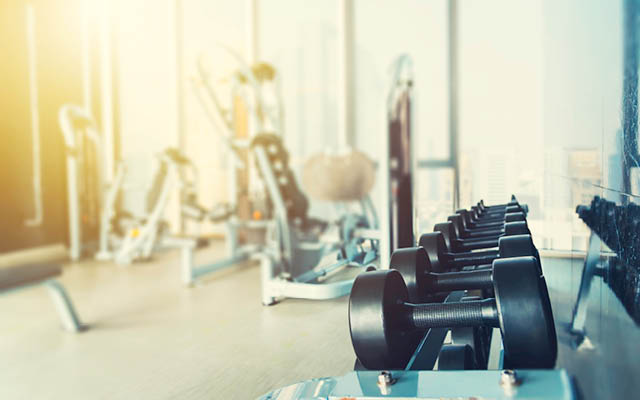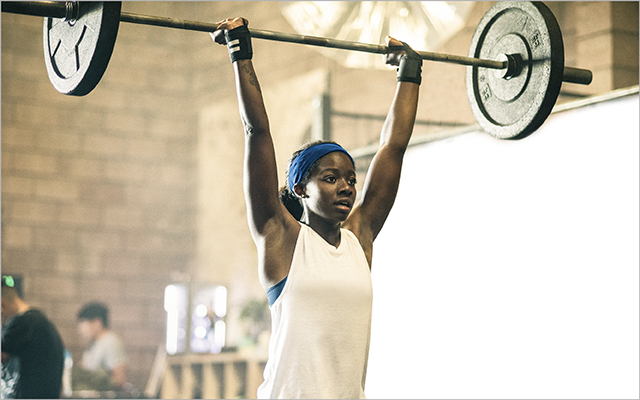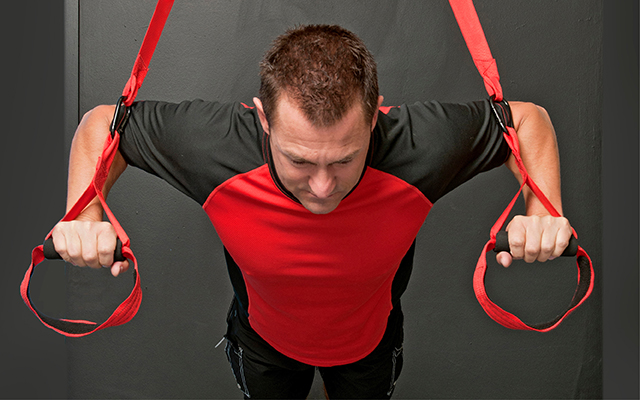Anyone who’s witnessed Olympic weightlifters in action knows that such power comes only through years of specialized and dedicated training. So it’s easy to write off all Olympic-lifting moves as being far too advanced for most of us.
Not so fast: While the two official Olympic weightlifting movements – the snatch and the clean and jerk – are highly advanced exercises that require proper training, several modified Olympic lifts (sometimes called Olympic-style lifts) are a bit easier to grasp, and virtually anyone can do them. If you’re looking for a full-body, time-efficient workout that builds muscle power and functional fitness, then Olympic-style weightlifting might be worth a try.
Just ask Mary Beth Schlichte, 46, a dental hygienist whose personal trainer at Excel Sport and Fitness in Waltham, Mass., introduced her to Olympic-style lifts, including the push press. “The push press alone gives my shoulders a better workout than all three of the regular shoulder exercises I was doing before, while also working my core and legs,” she says.
Old-School Fitness
Modified Olympic lifts have become popular recently, but their roots can be traced to the snatch and the clean and jerk, Olympic events since 1896. “In the snatch, the athlete is required to lift the bar from the ground to overhead in one motion,” says John Cissik, author of An Introduction to Olympic Weightlifting. “It’s a very fast and technical lift. Done right, it takes about a second or a second and a half to do. The clean and jerk involves lifting the barbell from the floor to your shoulders in one movement, and then lifting it overhead.”
“Every one of these lifts works almost every major muscle in your body.”
“Olympic weightlifters have an ability to express a tremendous amount of strength very quickly,” notes Cissik. In other words, they are very powerful. And yet even ordinary athletes can develop at least a dose of that power with Olympic-style lifts. And they can do it in less time than more conventional workouts – because, as Cissik explains, “Every one of these lifts works almost every major muscle in your body.”
The best part: The power you develop translates to almost any other activity, including running and jumping sports, says John Sullivan, the USA Weightlifting–certified club coach who introduced Schlichte to Olympic-style weightlifting. Indeed, experts contend that muscle power has important benefits beyond simply building maximum strength or size.
A 2000 study published in the Journals of Gerontology revealed that loss of muscle power, not muscle strength, is the primary cause of declining functional capacities (climbing stairs, lifting objects) among elderly women. And power training is the most effective way to reverse this decline.
Getting Started
Modified Olympic-style lifts typically mimic parts of traditional Olympic lifts. For example, instead of lifting a barbell overhead from the ground in one motion, as in the snatch, you might lift it from the knees to the shoulders, as in the hang clean (below). While easier to learn and less risky than standard Olympic lifts, even the modified versions can result in hamstring strains and ruptured disks if you begin lifting without adequate preparation. So, to get the benefits while avoiding the risks, follow these rules:
Build balance and strength before lifting heavy.
Don’t begin any Olympic-style lifting program without having first done some extensive strength training, says Paul Chek, founder of the C.H.E.K Institute, a corrective exercise facility in Vista, Calif. That includes stretching tight muscles and strengthening important stabilizing muscles, such as those in your core and shoulders.
“Before you try any kind of power exercise, you first need to balance your muscles, create stability where you need it and improve your overall strength in whole-body movements,” Chek says.
Learn technique from a qualified trainer.
“Trying to teach yourself how to do Olympic lifts is like trying to teach yourself how to do karate,” says Sullivan. “You could mimic the basic movements, but there are many nuances of proper technique that you’ll never master without an expert watching you and correcting your mistakes.” Look for trainers with certifications from USA Weightlifting (www.usaweightlifting.org).
Prioritize speed and form over weight.
Technique and speed are more important than the amount of weight you lift. “You can’t let your ego get in the way,” notes Sullivan. “Start with a broomstick if you have to.”
“You can’t let your ego get in the way,” notes Sullivan. “Start with a broomstick if you have to.”
As you develop better coordination, gain confidence and increase your power, you can start lifting heavier weights. But don’t attempt to lift more than you can hoist five or six times with perfect form and without slowing down.
Why so few reps? “If you start doing 10 and 20 repetitions, your technique breaks down, and instead of training yourself to be fast and explosive, you train yourself to be slow and sloppy,” says Cissik.
Hang Tough
You can best integrate Olympic-style lifts into your resistance-training program by performing one or two exercises at the beginning of your normal gym workout. “At first, do the lifts as part of your warm-up,” advises Sullivan. “Do some dynamic stretching, and then practice the Olympic lifts with very light weight before moving on to your regular strength exercises.”
Start with the push press and the hang clean, he says. When you’ve mastered the movements, you can add weight and separate the lifts from your warm-up. “But continue doing them first in your workout, when you’re fresh.”
How to Do the Push Press
1. Stand with a wide, overhand grip on a barbell (weighted or unweighted), your elbows pointed forward, your shoulders supporting the weight. Draw a deep breath and hold it, while tightening your abs as if you’re about to be punched in the stomach. This will tighten the muscles around your spine and aid the transfer of forces from your legs to your arms in the explosive movement that follows.
2. Bend your knees and lower yourself into a half squat.
3. Immediately reverse this movement, powerfully straightening your legs and hips.
4. The upward momentum created by straightening your legs should simultaneously assist your shoulders and arms in pushing the barbell toward the ceiling. This allows you to lift more weight than you could with a standard shoulder press. (Remember to keep the weight light until you’ve mastered the movement.)
To complete the movement, slowly lower the barbell to your shoulders, bending your knees slightly to absorb the weight of the bar.
(See “How to Mix Up the Overhead Press“.)
How to Do the Hang Clean
1. Stand with a shoulder-width overhand grip on a barbell and your arms fully extended toward the floor, so the barbell is resting against your thighs. Draw a deep breath and hold it as you tighten your abs to stabilize your core. Bend your knees and hips slightly and lower the barbell to the tops of your knees. (Do not bend too far forward at the waist.)
2. From this position, explosively straighten your knees and hips and draw your shoulders toward your ears, bending your elbows and pulling the barbell straight upward.
3. Without trying to “muscle” the bar upward with your shoulders and back, use a quick shoulder-shrugging action to initiate a powerful straightening of the hips and knees that, in turn, “floats” the bar upward toward your shoulders.
4. As the barbell moves upward, bend your knees and hips once more and swivel your hands under the bar, enabling you to catch it at shoulder height in a quarter-squat position with your elbows sharply bent and your palms facing the ceiling.
Pause very briefly in this position and then stand fully upright, rotating your shoulders and elbows and straightening your arms, so you can lower the barbell to its original “hang” position.
(See “How to Power Clean” for additional form instructions.)
Debunking Olympic-Style Lifting Myths
Myth No. 1: It’ll make me huge.
Research has shown that all types of power training – Olympic-style lifts included – tend to increase muscle density more than muscle size. “Olympic lifts are actually terrible for increasing muscle mass,” says John Cissik, author of An Introduction to Olympic Weightlifting.
Myth No. 2: It requires an Olympic bar.
Olympic competitors always lift with an Olympic bar, but you can use dumbbells, kettlebells or other forms of resistance when performing the modified lifts. In fact, some trainers hardly ever use a bar. “I don’t use Olympic bars with anyone except Olympic lifters,” says Paul Chek, founder of the C.H.E.K Institute in Vista, Calif. He believes that the independent limb movements demanded by dumbbells better simulate sports movements and everyday activities.
Myth No. 3: it requires a spotter.
“With Olympic lifts, it’s more dangerous to have a spotter than to not have one,” says John Sullivan, a USA Weightlifting–certified club coach and co-owner of Excel Sport and Fitness in Waltham, Mass. “When you miss an Olympic lift, the worst thing you can do is to try to catch the bar and fight it, or for a spotter to try and do the same thing.” While most fitness facilities frown on weight-dropping under normal circumstances, in an emergency situation, that’s still your safest bet.
This article originally appeared as “Lift Like and Olympian.”




This Post Has 0 Comments